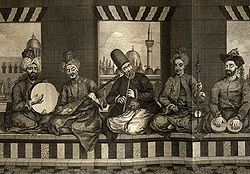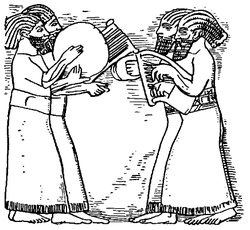Riq
Etymology and Alternative Spellings
Daf Riqq Reqq Rik
Construction
History
The Pahlavi (Middle Persian) name of the daf is dap.[1]
Some pictures of daf have been found in paintings that date before the Common Era. The presence of the Iranian daf in the 6th–5th century BCE Behistun Inscription suggests that it existed before the rise of Islam and Sufism.
Iranian music has always been a spiritual tool.
It shows that daf played an important role in Mazdean Iran emerging as an important element during the Sassanian period, during the Kâvusakân dynasty.
Also, there is a kind of square frame drum in the stonecutting of Taq-e Bostan (another famous monument located 5km northeast of Kermanshah city). These frame drums were played in the ancient Middle East, Greece, and Rome and reached medieval Europe through Islamic culture.
Nowruz (the first day of the Iranian New Year and the national festival of the Iranian people) and other festive occasions have been accompanied by daf in the Sassanid periods (224 AD–651 AD). In this period the daf was played in order to accompany Iranian classical music.
Dafs were likely used in the court to be played in the modes and melodies of traditional music. This traditional or classical music was created by Barbod the Great and was named the khosravani after the mythical king Khosrow II.
Recent research reveals that these modes were used in the recitation of Mazdean (Zoroastrian) prayers. The modes were passed down from master to student and are today known as the radif and dastgāh system.
Many of the melodies were lost, but most of those that remain date to the Sassanid period. Dafs can be played to produce highly complex and intense rhythms, causing one to go under a trance and reach an ecstatic and spiritually-high state. For this reason, they have always been connected with religion in Iran.Template:Citation needed

An engraved bronze cup from Lorestan at the National Museum of Iran in Tehran, portrays a double ney (end-blown reed pipes), chang (harp), and a daf in a shrine or court processional, as similarly documented in Egypt, Elam, and the Persian province of Babylonia, where music was arranged for performance by large orchestral ensembles.[1]
The Arabs introduced the daf and other Middle Eastern musical instruments to Spain, and the Spanish adapted and promoted the daf and other musical instruments (such as the guitar) in medieval Europe. In the 15th century, the daf was only used in Sufi ceremonies; the Ottomans reintroduced it to Europe in the 17th century.Template:Citation needed
The daf still functions as an important part of Iranian music (both traditional and classical) as it did in ancient times. It successfully encourages many young Iranians to take up learning this ancient instrument.
Daf, and its smaller version called dafli, is also used across India.[2] It is believed to have arrived along with other Persian influences in the medieval era, and is a popular folk instrument. In southern India, its use became mainstream, especially in protests, during the early half of the 20th century.[3] Since the 1950s, it has also been used prominently in Bollywood.[3]
In Islam
In some forms of Islam, daf holds special importance because some Muslims believe that it is the only musical instrument which is permitted to be used.[4] Other Muslims believe musical instruments in general are allowed, not exclusively the daf.[5][6]
The Prophet of Islam, Muhammad, did not impose a total prohibition on using the daf, stating that it is permissible during Eid, a wedding Walima, or to greet a government official after they arrive from a journey.[7]
It has always been an important part of Islamic Sufi music.[8]
- ↑ 1.0 1.1 Template:Cite web
- ↑ Cite error: Invalid
<ref>tag; no text was provided for refs namedInEx - ↑ 3.0 3.1 Template:Cite web
- ↑ Template:Cite book
- ↑ Template:Cite web
- ↑ Template:Cite web
- ↑ Template:Cite book
- ↑ Template:Cite book
